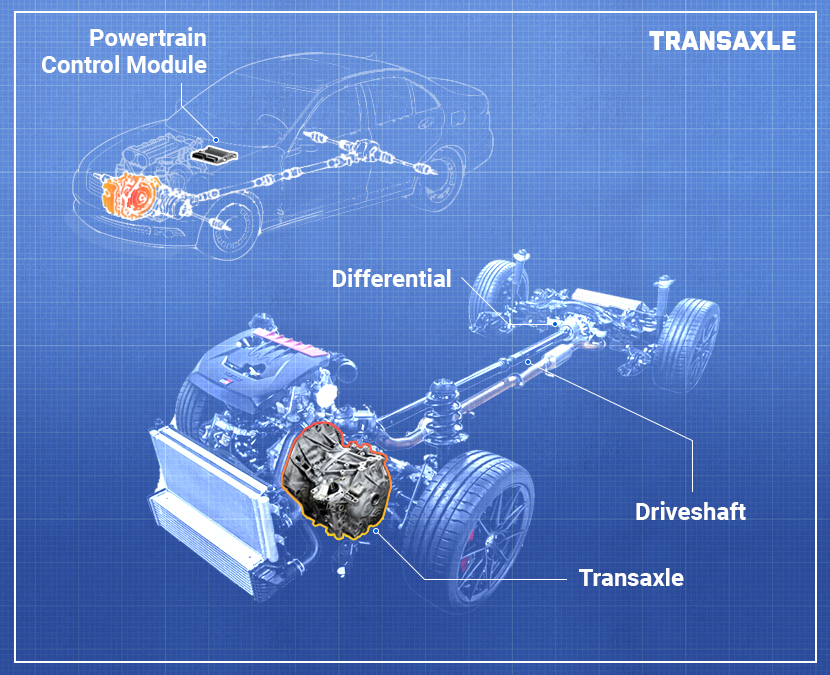Transaxle
As its name indicates, a transaxle combines a transmission with a differential in a single unit. It is a very complex mechanical device that performs the functions of both mentioned devices, transferring engine power and torque to the wheels. Just like a transmission, a transaxle can be of either a manual or automatic type. Whichever the type, it is connected to the engine on one side and to the driving wheels on the other one, allowing a vehicle to move forward or backward.

A transaxle is not something luxury or exotic. It can be found in many vehicles which feature an engine and driving wheels at the same end. As a rule, they are front-wheel drive vehicles as well as some rear-engine rear-wheel drive cars. In addition, several mid-engine and front-engine rear-wheel drive sports cars are also equipped with a transaxle. In most cases, a transaxle is more compact compared to a transmission-differential arrangement, which makes the vehicle lighter and allows for installing an engine close to the drive wheels. It also ensures better weight distribution when it comes to front-engine rear-wheel drive sports cars.
A transaxle is a key part of a vehicle’s drivetrain, so its failure will affect just about any aspect of vehicle operation. Good news is that it is designed to last the life of a vehicle, however, it may get a premature failure due to a lack of maintenance and manufacturing defects. If so, you should notice an array of warning signs:
Abnormal noises coming from the transaxle
Any strange noises, including, but not limited to whistling, grinding, humming, clicking and clunking, are triggers of a failing transaxle. Depending on the sound and the place it comes from, a professional can determine the root of the problem. This can be a differential, CV joint or a transmission.
Incorrect shifting
Hard shifting, transmission slippage or inability to shift into a specific gear can be signs of a failing transaxle. None of these symptoms should be ignored as this may lead to severe transaxle damage.
Your vehicle doesn’t move
In the worst-case scenario, your vehicle will not move if your transaxle completely fails. This may happen due to several reasons. Your transaxle may not be able to transfer power to the wheels or it cannot shift into any gear. In this case you should have your car towed to a repair shop for inspection and repairs.
Smell of burning fluid
If your transaxle gets overheated, you may notice a smell of hydraulic fluid that is burning. If so, stop the car and get in touch with your mechanic for advice. It is also a good idea to check the fluid level and read the manufacturer’s recommendations found in your owner’s manual.
Fluid leaks underneath the vehicle
If you see marks of oil or fluid under the car, especially close to the transaxle area, they can be caused by a leaking transaxle. Inspect the transaxle for leaks and physical damage, and check the fluid level to prevent transaxle overheating.
Driving a vehicle with symptoms of a bad transaxle is a perfect way to destroy your drivetrain. Combining both your transmission and differential, the transaxle is what delivers power from the engine to your drive wheels. That’s why any transaxle related problem should be addressed once it appears if you don’t want to find yourself standing on the roadside one day. Besides, ignoring signs of a failing transaxle can lead to very expensive repairs with a lot of headache.
How to fix a bad transaxle
A transaxle is a very complex device, so its diagnosis and repair should be done by a professional. In most cases, this will involve sophisticated skills and special tools. The amount of labor and the final repair cost will depend on the damage caused to the drivetrain and the cost of replacement parts.
Your transaxle will have to pass through a variety of inspections and tests, including a visual test, checking for fluid leaks, reading trouble codes stored in the powertrain computer, etc. Your mechanic will also need to disassemble the transaxle to check all internal parts for signs of wear and damage. In many cases you’ll be advised to replace all worn-out parts to prevent possible problems in the nearest future. The last step is refilling your transaxle with fresh hydraulic fluid and a driving test to ensure the transaxle performs as it should.
If your transaxle has got severe damage it may need to be rebuilt or even replaced with a remanufactured or brand-new unit. If your car or truck is new and doesn’t have a lot of mileage, replacing the transaxle with a remanufactured or new assembly can be the best way to go as the replacement comes with the manufacturer’s warranty. On the other hand, replacing the transaxle when your vehicle is in the end or the middle of its lifespan is often unreasonable since the repair price can be almost equal to the cost of the car. In this case, you may go with a used transaxle to cut the expenses.
Can I fix or replace a transaxle myself?
Unless you’re a professional mechanic with lots of experience in this field, we would not recommend you doing the job yourself. Most likely, it will involve heavy equipment to lift the vehicle and special tools for your transaxle diagnosis and repairing. Besides, you may cause occasional damage to other drivetrain components and even hurt yourself while working on the transaxle. What you can really do is to prevent serious damage to the transaxle by replacing the hydraulic fluid at the manufacturer’s recommended intervals and topping it up if necessary.